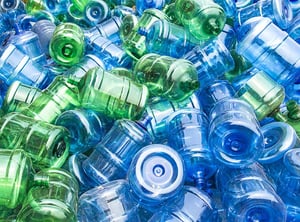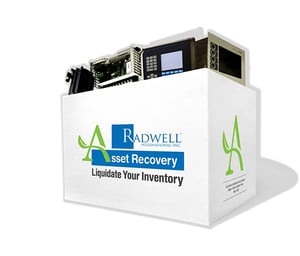Recycling has been around for centuries. The first known use of recycled paper dates to 9th century Japan, when the Japanese government ordered that all paper waste be re-pulped and reused to make new paper. Recycling became popular in the United States during World War II, when tens of thousands of tons of material was recycled to create tanks, guns, ammunition and other war supplies. According to the EPA, from 2005 to 2015, there was a 53.3 million ton increase in recyclable materials recovered from the U.S. municipal solid waste stream.
Recycling is a broad word for a complicated process. Under recycling there are three subcategories: upcycling, downcycling and asset recovery. Read on to learn the differences between these kinds of recycling and how they are transforming industries.
Upcycling
 Upcycling is the transformation of byproducts, waste and unwanted products into new products that have higher environmental quality and value than the originals. The goals of upcycling are to prevent useful materials from going to waste and to reduce the consumption of raw materials. The process also saves on the energy that would be used to create new products from raw materials.
Upcycling is the transformation of byproducts, waste and unwanted products into new products that have higher environmental quality and value than the originals. The goals of upcycling are to prevent useful materials from going to waste and to reduce the consumption of raw materials. The process also saves on the energy that would be used to create new products from raw materials.
In 2014, JetBlue updated their crew member uniforms. This left the company with thousands of old uniforms and nothing to do with them. Instead of throwing the uniforms away, however, JetBlue gave them to Manhattan Portage to be upcycled and resold as new products. The uniforms were used to create products such as computer bags, backpacks and toiletry bags for the Jet Blue x Manhattan Portage line.
Looptworks is an online store that sells upcycled products -- bags, wallets, backpacks, travel bags, laptop cases, apparel and more. Every product on the company’s website is upcycled. Looptworks often collaborates with larger companies to create something new from old materials; its partners have included Southwest, Delta Airlines, the University of Oregon Ducks and the NBA.
Upcycling is important because the process reuses what is already available. Companies can use upcycling to make new products out of what they already have. By avoiding the expense of new materials production, costs and energy use are reduced; by offering an alternative to discarding old products, environmental waste is cut down.
Downcycling
 Downcycling can be thought of as the opposite of upcycling. Downcycling recycles waste that cannot be made into a higher quality product in its present form. The goal of the process is to transform materials with low quality and functionality into materials that can be used to create new products.
Downcycling can be thought of as the opposite of upcycling. Downcycling recycles waste that cannot be made into a higher quality product in its present form. The goal of the process is to transform materials with low quality and functionality into materials that can be used to create new products.
The most common downcycled material is plastic, like that used in water bottles. Water bottles, generally speaking, are single-use products – but once melted down, the resins from which they are made can be turned into products such as fibers for pillows or insulating fill for winter clothing. Parking lot bumpers, railroad ties, truck bed liners, car parts and many more products can also be created from downcycled plastics.
The consumer electronics industry regularly uses downcycling, as well. During Apple’s September 2018 keynote event, Lisa Jackson, head of environmental initiatives at Apple, announced that the company is trying to limit the amount of mining needed for product manufacturing. To help achieve this goal, Apple is encouraging its customers to participate in a recycling program that is essentially a downcycling effort: Old Apple products are taken in and stripped of any valuable materials that can be reused; new Apple products can then be created with those downcycled materials.
Downcycling is an important trend reducing the mining of new materials from the Earth – a process that uses significant amounts of energy and causes high greenhouse gas emissions, air pollution and water pollution.
Asset Recovery
 Another form of recycling that helps reduce waste in the manufacturing industry is asset recovery. The process finds ways to reuse industrial assets, allowing companies to liquidate excess and aging inventory or to remove obsolete install bases. An example can be seen in Radwell International Inc., a provider of MRO and industrial automation products, repair services and asset recovery solutions. Most of the surplus industrial electronics Radwell purchases can be resold to companies seeking low-cost replacements to keep their plants up and running. Radwell helps keep items like programmable logic controllers (PLCs), drives, motors, electronic parts, circuit boards, meters, sensors and all types of industrial controls out of landfills.
Another form of recycling that helps reduce waste in the manufacturing industry is asset recovery. The process finds ways to reuse industrial assets, allowing companies to liquidate excess and aging inventory or to remove obsolete install bases. An example can be seen in Radwell International Inc., a provider of MRO and industrial automation products, repair services and asset recovery solutions. Most of the surplus industrial electronics Radwell purchases can be resold to companies seeking low-cost replacements to keep their plants up and running. Radwell helps keep items like programmable logic controllers (PLCs), drives, motors, electronic parts, circuit boards, meters, sensors and all types of industrial controls out of landfills.
Let’s recycle!
Recycling happens in multiple directions. It can help companies lower their energy costs, minimize their carbon footprint and reduce the amount of waste being produced. With a deeper understanding of the various aspects of recycling, industries everywhere can reap the rewards.
For more information about Radwell International
For a behind the scenes look at Radwell


